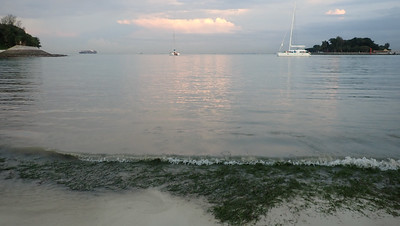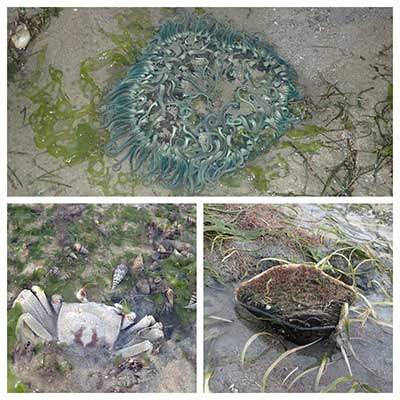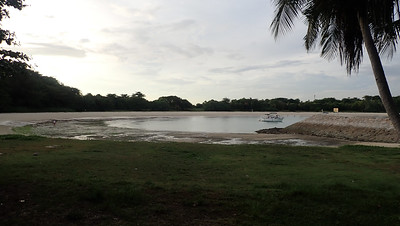I was blown away to see lush growths of rare seagrass species flourishing in the lagoon. The team also found cone snail and other amazing marine life.
We start the survey on the rocky southern tip of Lazarus. As usual, there aren't many hard corals. Most were boulder shaped and had dead portions on the top (which is exposed at low tide) but none were bleaching.
On the sandy areas, there were Common sea stars, Cake sand dollars, Oval moon snails and signs of Acorn worms and sand bubbler crabs. It was nice to see an Orange-mouth olive snail which I rarely encounter. In the rubbly areas there were Giant carpet anemones and Long black sea cucumbers. While the rest of the team saw cone snail and pretty gobies and more.
Kelvin found a live cone snail!My main mission on this rocky shore was to check up on the Critically Endangered Bonduc (Caesalpinia bonduc). It was badly chewed up with hardly any leaves on it the last time I saw it in Mar 2021. I'm relieved to see that it is lush and healthy today, it was even flowering! This is a very prickly bad-tempered plant! Its fierce hooks will catch onto clothing (or bare skin!) and are hard to dislodge. There are only a few plants known in the wild in Singapore. The one on Lazarus is a male plant, I have seen the female plant on Pulau Semakau.
I saw a wider variety of corals on the shore facing Kusu Island. With some really large, well formed ones.
There were also lots of Asparagus flowery soft corals, as well as a good variety of Leathery soft corals. On this stretch, I saw a Red feather star and a Spider conch snail.
I was so excite to walk the entire lagoon that I didn't have time to slowly comb through the seagrasses for critters. I only noticed large animals. Like the beautiful Snaky sea anemone which is not very commonly encountered in the South. There were also many small snails, a large Fan shell clam and a Ghost crab hunkered down in the soft silty sand.
Close to sunset, the tide is at its lowest and I had a quick glimpse of the artificial shores at Seringat-Kias lagoon. I was delighted to see lush seagrasses growing all around this huge lagoon. The situation seems a lot better than the last time I surveyed at such a low tide, in Nov 2019. Today, there is a lot more Noodle seagrasses and Tape seagrasses.At the mouth of the lagoon on both the south and north, there was small patches of Sickle seagrass.As well as dense growths of Spoon seagrass (small leaves) and Needle seagrass (narrow leaves).
Towards the southern arm of the lagoon, there was still a large patch of Smooth ribbon seagrass. Some of those near the high shore was bleaching.
I saw about 20 clumps of Tape seagrass growing all around the lagoon. The Tape seagrasses at Seringat-Kias are probably the healthiest that I've recently seen from all our other shores.
They had nice healthy long leaves, I didn't see any that were cropped. And most were blooming. There were fresh female blooms as well as male flower bracts with fresh male flowers too - tiny floating flowers that look like styrofoam beads).
The most amazing thing to see, however, was the lush Noodle seagrass with fresh and often long (30cm and longer) leaves growing all around the lagoon from the south to the north and all along the central part. These are probably only exposed at a good low spring tide like today. Noodle seagrass is not often encountered on our shores.
It was sad to see a freshly abandoned fishing net (about 20m long) in front of a reefy part of Lazarus near the seawall. The rest of the team checked out the net and released crabs and a lobster trapped it in. Today, I didn't see as much litter in Seringat Kias bay. Mostly the usual trash that look like they came from passing ferries (single-use water cups).
The southern shore of Lazarus that we surveyed today has seawalls. But this is minor compared to the massive reclamation that created Seringat-Kias, which buried the submerged reefs of Seringat and Kias and connected it to the natural Lazarus Island. A causeway bridge joins these with St. John's Island. Here's more about what was done to create Seringat-Kias. Besides the lush seagrasses in the large artificial lagoon, mangroves and seagrasses have also settled in a smaller Mangrove Lagoon - I last surveyed this in Nov 2020.
Lazarus Island in the Singapore Blue Plan
The cluster of Kusu, Lazarus and St. John's Islands has been recommended by the Singapore Blue Plan 2018 for elevated protection status.
 |
| Kusu Island (left), natural Lazarus Island and artificial Seringat-Kias. |
DOWNLOAD the Plan, SUPPORT the Plan! More on the Singapore Blue Plan 2018 site.
Photos by others on this survey
Kelvin Yong
Che Cheng Neo
Tang Yong Jen
















